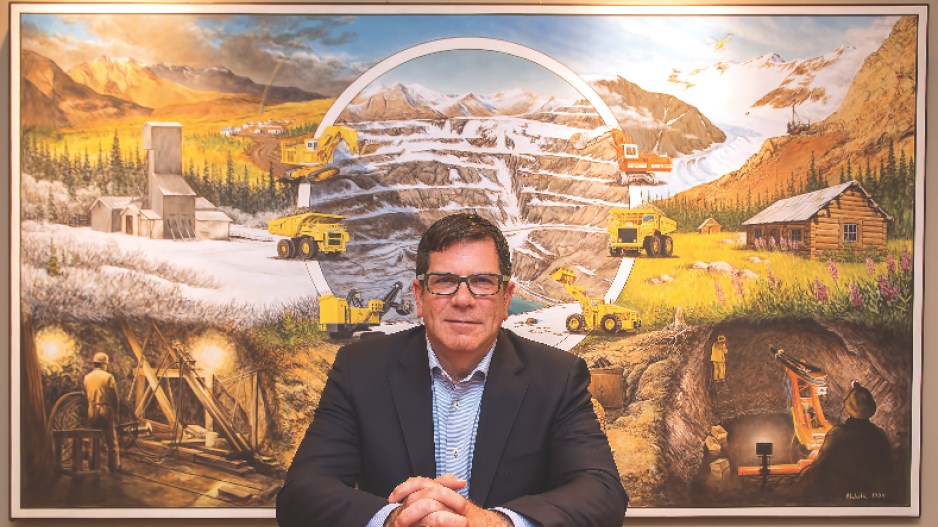On his second day in office, Michael Goehring, newly appointed president and CEO of the Mining Association of British Columbia (MABC), was caught in a flurry of requests from multiple parties anxious for his attention.
After a brief vacation in Las Vegas, Goehring started his role on May 1, directly following two decades in his previous position as partner at National Public Relations, Canada’s largest communications firm. Goehring has more than 20 years of experience in public affairs and strategic communications in the mining, energy, forestry, utilities, technology and trade industries.
In between a packed second day schedule, Goehring spoke with Business in Vancouver about the current state of Canada’s mining industry, what looms ahead for the volatile sector and how he hopes to contribute in his new role.
Q: Can you share a little bit about your background?
A: I was born and raised in Vancouver and I pursued a degree in political science at the University of British Columbia and then pursued grad studies in political economy at Simon Fraser University.
As a young boy, I was interested and taken by B.C. history, in particular stories of the gold rush. On summer holidays, we journeyed up the Fraser Canyon to the Interior of B.C. and there was plenty of allure on the gold rush and how it helped build our province.
My interest in mining was only heightened when I began to work in communications and work in and around the modern mining industry.
Q: How will your history in public affairs and strategic communications help in your new role?
A: [My experience] enables me to advance challenging policy files and deliver successful advocacy and communication campaigns that deliver results. These are critical skills for an industry association, in particular for an industry that is heavily regulated.
Q: What is the current state of the mining industry, and what are some of the major issues affecting the sector?
A: There are major issues that have been confronting us that have to do with a changing regulatory landscape, continuing volatility in global markets, and the availability and training of our labour force.
We have had a mixed couple of years that we have experienced – projects have been moving forward but we also have seen delays in project approvals and new investment when we compare ourselves to other jurisdictions.
We have successfully completed a code review and we continue to engage with government well on regulation and ways in which mining can support a lower-carbon future. We are working with the province to ensure that B.C. is a competitive jurisdiction for mining investment going forward.
Q: In what ways do you see high tech and innovation fuelling the future of mining in Canada?
A: Autonomous vehicles and drones are allowing for faster, safer and more efficient operations, whether that’s the collection of survey data or the measurement of loads or assessing risk of slides in tunnels and slopes. These all make for a safer mine site for our workers and for a more productive mine site.
Virtual intelligence and machine learning are already providing insight into project assessments. We are seeing large data sets from survey work from some companies that are vastly improving efficiency in assessments, and that supports better decision-making by geologists and flows through to better decision-making for investors.
Another innovation is improvements to battery technology and alternative energy, which enables our mines to lower their carbon footprint and also offsets some of our demand for power, which reduces our dependency on legacy fuels like diesel.
Q: What are some under-represented mining industry issues?
A: Mining supports our modern way of life and it’s critical in advancing this lower-carbon future that we are all trying to achieve. Cellphones, electric vehicles, public transit, all these things and more require mined material to produce and manufacture.
I don’t think that registers with a great majority of the public, nor does the fact that the innovation that we are seeing in the mining sector is being driven by B.C. firms in partnership with our industry…. The mining sector along with the high-tech sector are advancing change globally in the mining industry.
Q: Anything else we should know?
A: At the MABC, we are proud that our industry has led the way in consultation, engagement and economic reconciliation. We are the largest private-sector employer of Indigenous people in B.C. We have a lot of work ahead of us but that’s another piece I am excited about.
Additionally, May is B.C. Mining Month, and there are events occurring across B.C. at a number of mining communities in the Interior, in the north, the southeast and here in Surrey. I would encourage anyone interested to go online and learn more. •
This interview has been condensed and edited.




